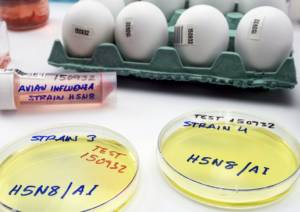There have been alarming reports of human cases of bird flu that have been confirmed to be occurring undetected in the United States. Cases of the highly pathogenic avian flu have been found in individuals, as evidenced by blood samples from 115 dairy workers in Michigan and Colorado. Researchers from the US Centers for Disease Control and Prevention (CDC) have detected antibodies from the extremely virulent strain of H5N1 in the blood of 7% of the tested individuals between June and August 2024.
The good news is that the majority of individuals who have contracted avian flu so far have not experienced significant damage. It is possible that only mild symptoms were encountered by half of the individuals with virus antibodies in their bloodstream, as they did not report feeling unwell.
However, researchers are concerned that the virus’s potential to mutate into more lethal variants is increased by its unchecked spread, despite the current low risk to public health. In Cambodia, the disease’s virulence has undergone a transformation, resulting in the deaths of at least three patients. This strain of avian flu, which was transmitted from poultry, is a hybrid between 2.3.2.1c and 2.3.4.4b. A preprint study suggests that this hybrid contains mutations that facilitate airborne transmission and infection of mammals. Fortunately, close monitoring indicates that the Cambodian outbreak is contained, with no human-to-human transmission identified.
Canada recently reported its first human case of bird flu. The patient, an adolescent, is hospitalized in critical condition with a mutated virus strain identified in the US dairy cattle outbreak. Genetic sequencing reveals a mutation in a gene enhancing the virus’s ability to infect humans. While the Canadian case appears to be isolated, these instances highlight the virus’s susceptibility to changing risks, emphasizing the need for meticulous outbreak management and monitoring.
Currently, there is only one confirmed case of avian flu with no known animal origin, raising concerns of potential person-to-person transmission. Dairy laborers in the US who showed symptoms of previous infection were mainly involved in milking cows or cleaning the milking parlor. Symptoms reported include fever, sore throat, congestion, diarrhea, and headaches, along with eye irritation. The workers did not use recommended personal protective equipment (PPE) for working with infected animals, emphasizing the need for increased outreach and training.
The CDC is closely monitoring the situation. The highly virulent avian flu has affected over 400 dairy herds in 48 states, in addition to poultry outbreaks. Researchers stress the importance of rigorous surveillance to prevent further spread and manage current outbreaks in animals.
The need for enhanced outreach to educate employers and employees about infection risks and prevention measures is crucial, especially for those working with dairy cattle infected with HPAI A(H5) viruses. Culturally appropriate outreach is essential, as many workers are Spanish speakers. Worldwide authorities urge reporting sightings of sick birds and maintaining good hygiene when interacting with animals.
Symptoms of infection in animals include drowsiness, lack of coordination, inability to stand or fly, circling movement, head tilt, and loss of coordination. The highly virulent avian flu has led to the culling of over 90 million domestic birds in the US since 2022. A vaccination program has been implemented to protect critically endangered species like the California condor, while efforts continue to develop a human vaccine against the virus.






